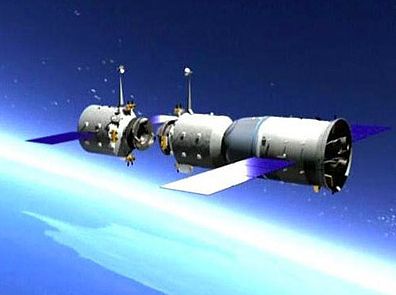China to Put Space Station in Orbit by 2024
Article by Joel Gehrke April 14, 2021 (washingtonexaminer.com)
• “There’s just no question, as a general matter, that China is focused on achieving leadership in space,” the Director of National Intelligence, Avril Haines, told a Senate oversight panel. China is expected to launch its own space station (pictured above) into low-earth orbit by 2024, and Chinese officials have “entered [the] pre-launch phase” for the core of a low-earth orbit space station. This project is expected to unfold in stages over the next few years, and Chinese General Secretary Xi Jinping aspires to make the space station a highly visible display of China’s ambitions.
• “We expect a Chinese space station in low Earth orbit (LEO) to be operational between 2022 and 2024,” the Office of the Director of National Intelligence said in a recently released report. “China also has conducted and plans to conduct additional lunar exploration missions, and it intends to establish a robotic research station on the Moon and later an intermittently crewed lunar base.”
• A trio of Chinese astronauts could be living in the core module within months. “China is aiming to construct its three-module space station with 11 launches across 2021-2022,” says Space News. “These will consist of three module launches and visits by four crewed missions and four cargo spacecraft. Chinese astronauts are currently in training for space station missions, with 12 astronauts expected to fly on the four missions.”
• A Chinese space station put into orbit with the assistance of Russian experts would be a major achievement for the Chinese, and would punctuate China’s emergence as a rival to the U.S. in space. “To fly humans in space and do it successfully, you have to master every field of technical endeavor — chemistry; physics; every form of engineering; medicine, you name it, you have to be a master in it,” Scott Pace told the Washington Examiner in 2018 when Pace was the executive secretary of the White House National Space Council.
• Chinese state media portrays this development as a peaceful display of China’s interest in space. “China’s space missions are mainly for peaceful purposes, and fruits of development can be shared with others, to offer great help to the progress of space technology, which is different from the U.S.’s space technology that mainly serves the military,” Chinese aerospace expert Song Zhongping was quoted as saying.
• But NATO officials see a growing security risk from such capabilities. China has developed and used at least one kind of anti-satellite missile to destroy a weather satellite in 2007. The PLA will continue to integrate space services such as satellite reconnaissance, positioning, navigation, timing, and communications into its weapons command-and-control systems to erode the US military’s information advantage, warns Haines. “China has already fielded ground-based ASAT missiles intended to destroy satellites in [low-earth orbit] and ground-based ASAT lasers probably intended to blind or damage sensitive space-based optical sensors on LEO satellites.”
• Haines suggested that countering those threats would involve both Space Force and private sector initiatives. “The private sector has just become increasingly important in our efforts to contest and to work, essentially, against contestations to our leadership in space,” Haines told the senators. “Economically, from a security perspective, from a communications perspective, and from the perspective of just understanding and intelligence … we want to ensure that we continue US leadership in this area.”
• [Editor’s Note] And so retired US deep state government officials and military officers continue their drum beat for war against China, Russia or whomever they can draw into battle, while enticing deep state-controlled corporations to support the deep state’s war agenda with the promise of massive military contracts. Just business as usual for the deep state.
 China is expected to launch its own space station into low-earth orbit by 2024,
China is expected to launch its own space station into low-earth orbit by 2024,

American intelligence officials assess, part of an effort to surpass the United States as the preeminent space power.
“There’s just no question, as a general matter, that China is focused on achieving leadership in space, in effect, as compared to the United States,” Director of National Intelligence Avril Haines told a Senate oversight panel on Wednesday before urging further decision during a closed session.

Chinese General Secretary Xi Jinping aspires to make one very visible display of his ambitions in the coming weeks, as Chinese officials have “entered [the] pre-launch phase” for the core of a low-earth orbit space station, per state media. This project is expected to unfold in stages over the next few years, according to Haines’s team of analysts.
analysts.
“We expect a Chinese space station in low Earth orbit (LEO) to be operational between 2022 and 2024,” the Office of the Director of National Intelligence said in a report released this week. “China also has conducted and plans to conduct additional lunar exploration missions, and it intends to establish a robotic research station on the Moon and later an intermittently crewed lunar base.”

A trio of Chinese astronauts could be living in the core module within months, according

to a trade publication analysis. “China is aiming to construct its three-module space station with 11 launches across 2021-2022,” Space News observed this week. “These will consist of three module launches and visits by four crewed missions and four cargo spacecraft. Chinese astronauts are currently in training for space station missions, with 12 astronauts expected to fly on the four missions.”
Those ambitions would punctuate China’s emergence as a rival to the U.S., which launched the International Space Station in 1999, placing “the third brightest object in the sky” into orbit with the assistance of Russian experts — a cooperative effort intended at the time to demonstrate post-Cold War comity and technological possibility. It would be a major achievement and opportunity for Chinese researchers.
FAIR USE NOTICE: This page contains copyrighted material the use of which has not been specifically authorized by the copyright owner. ExoNews.org distributes this material for the purpose of news reporting, educational research, comment and criticism, constituting Fair Use under 17 U.S.C § 107. Please contact the Editor at ExoNews with any copyright issue.


